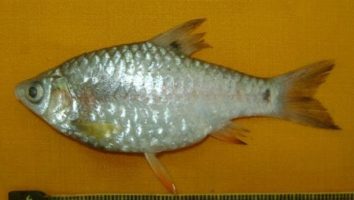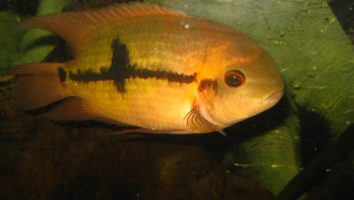The Pacific blue-eye is a stunning and relatively peaceful freshwater fish that is perfect for beginner and experienced aquarists alike.
This species is relatively easy to care for and can be kept in a wide range of tank sizes. They are also compatible with a wide variety of tank mates.
In this guide, we will teach you everything you need to know about Pacific blue-eye care. You will learn about their diet, tank size, lifespan, and more!
Table of contents
Species overview
The Pacific blue-eye (Pseudomugil signifer) is a type of freshwater fish that’s found near Australia and New Guinea.
They inhabit a wide range of different habitats, but prefer slow-moving streams and rivers with plenty of vegetation. This is something to keep in mind if you’re planning on keeping them in your own aquarium.
While they are peaceful fish, Pacific blue-eyes can be quite territorial. This is especially true when it comes to their breeding grounds. In the wild, they build nests out of plants and other materials in order to lay their eggs.
The Pacific blue-eye is a very popular fish in the aquarium trade. This is due in large part to their beautiful blue coloration.
Appearance

The Pacific blue-eye is a smallish freshwater fish that, as you might guess from their name, has very blue eyes. In fact, their eyes are so blue that they almost seem to be glowing.
These fish have a very sleek and streamlined body that is mostly silver in color. The silver coloration fades to white on their bellies.
One of the most distinctive features of this fish is the black stripe that runs along their sides. This stripe is widest at the base of the fish’s tail and tapers as it goes towards the head.
The fins on the Pacific blue-eye are all fairly average in size. The dorsal fin starts about halfway back on the body and is tall and thin.
The caudal fin is forked and slightly taller than the dorsal fin. The anal fin is short and round. The pectoral fins are also short and round.
All of the fins on this fish are translucent with a slight blue tint.
Lifespan
The lifespan of a Pacific blue-eye is around 5 years. This number can be increased or decreased based on a number of different factors.
For example, if they’re kept in captivity then they might have a different lifespan than if they were in the wild. This is because they’re not as exposed to predators and other dangers.
The level of care they receive is also a big factor. If they’re in a well-maintained tank with good water quality then they’ll likely live longer than if they were in a suboptimal environment.
Size
The Pacific blue-eye is a small fish, with adults only reaching lengths of about 3 inches.
Tank
Tank Size
The minimum recommended tank size for a Pacific blue-eye is 30 gallons. If you’re looking for a nano fish that can live in a small aquarium, this is not the fish for you.
This fish is very active and needs a lot of space to swim. They’re also jumpers, so a tight-fitting lid is a must. A 30-gallon tank is the minimum recommended size, but a larger tank is always better.
Water Parameters
The Pacific blue-eye is a delicate fish that needs pristine water conditions. These fish are very sensitive to water quality and changes in water parameters.
The most important thing to remember when it comes to keeping Pacific blue-eye is to maintain consistency. Even small changes in water quality can stress these fish and lead to health problems.
Be sure to test the water frequently and make partial water changes as needed to keep the water quality high.
Here are a few basic water parameters to help create a healthy environment for Pacific blue-eye.
- Water temperature: 65 to 75 degrees Fahrenheit
- pH levels: 6.8 to 7.6
- Water hardness: 4 to 8 dGH
- Alkalinity Levels: 6-12 dKH
What To Put In Their Tank
When it comes to setting up the interior of an aquarium for Pacific blue-eye, the process is relatively simple.
The first thing you need to do is choose a substrate. These fish aren’t too picky, so you can go with gravel, sand, or even a combo of the two. Just make sure whatever you use isn’t too small since they might end up eating it.
After that, you’ll want to add some plants and décor. These fish like to have some places to hide, so including caves, driftwood, and rocks is a good idea.
You can also add some plants if you want. Just be careful not to go overboard since they might eat them. Hornwort, water wisteria, and java moss are all good choices.
Finally, you’ll need to add some water. Pacific blue-eye are saltwater fish, so you’ll need to use marine salt to make the water safe for them.
Common Diseases
Out of all the diseases that could potentially affect your Pacific blue-eye, the most common one is definitely ich.
Ich is a very contagious disease that’s caused by a parasite. It’s one of the most common freshwater fish diseases out there, and it can affect any species of fish.
The most obvious symptom of ich is the presence of white spots on the body, fins, and gills of your fish. If you notice this, it’s important to take action immediately.
If you don’t treat ich, it can quickly spread to the rest of the fish in your tank and it can even be fatal.
While ich is the most common disease that affects Pacific blue-eyes, there are plenty of other potential illnesses that could strike too.
Some other things to look out for are lethargy, loss of appetite, and strange behavior. If you notice any of these things, it’s always worth doing some research to see if there could be an underlying health issue.
The best way to prevent your Pacific blue-eye from getting sick is to maintain a clean and stable tank. This will create an environment that’s less conducive to disease and it will also make your fish more resilient to illness.
Behavior & Temperament
The Pacific blue-eye is a beautiful, peaceful fish that is perfect for almost any freshwater aquarium. They are relatively easy to care for, and their stunning blue eyes add a touch of elegance to any tank.
These fish are very social creatures and do best when kept in groups. They are very active swimmers and love to explore their surroundings. When they are first introduced to a new tank, they may be a bit shy. But, once they feel comfortable, they will be out and about in no time.
Pacific blue-eye fish are not aggressive and get along well with other peaceful fish. They are not known to nip at plants or bother other tank inhabitants.
One thing to keep in mind is that Pacific blue-eye fish are jumpers. So, be sure to keep a tight fitting lid on your tank to prevent them from escaping.
Tank Mates
The Pacific blue-eye is a peaceful community fish that does well with other non-aggressive species. They’re not particularly territorial, so you don’t need to worry about them picking fights.
These fish are also relatively small, so they can be housed with larger tank mates. Just make sure that the other fish in the tank aren’t particularly aggressive.
Here are some good Pacific blue-eye tank mates:
- Guppies
- Platies
- Mollies
- Swordtails
- Neon Tetras
- Cardinal Tetras
- White Clouds
- Danios
- Ember Tetras
Breeding
The Pacific blue-eye is a beautiful fish that’s native to Australia. They’re peaceful and make great additions to community tanks. They’re also easy to breed in captivity!
The first step is to set up a breeding tank. It should be at least 30 gallons and filled with soft, acidic water. You can use an aquarium with a sponge filter.
Then, add plenty of plants. Breeding Pacific blue-eyes requires a densely-planted tank. They like to lay their eggs on the leaves of plants.
Next, add a few pieces of driftwood for the fish to hide under. Driftwood will also help to lower the pH of the water.
When ready, add two females for every male. Pacific blue-eyes are polygamous breeders, so a male will mate with multiple females.
The breeding process is triggered by a change in water temperature. For Pacific blue-eyes, that temperature should be around 77 degrees Fahrenheit.
Once the eggs are laid, the male will guard them until they hatch. Eggs usually hatch in about two days.
After they hatch, the fry will feed on microscopic organisms in the water. You can supplement their diet with baby brine shrimp.
As they grow, you can gradually transition them to flake food.
Conclusion
The Pacific blue-eye is a beautiful fish that is perfect for the beginner aquarist. They are easy to care for and are very peaceful, making them a great addition to any community tank.
Their bright blue eyes are sure to catch your attention, and their playful nature will keep you entertained for hours.
If you’re looking for a low-maintenance fish that is still interesting and fun to watch, the Pacific blue-eye is the perfect choice for you.












